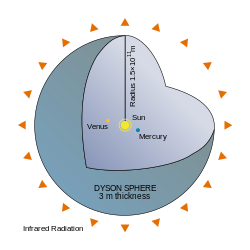This article has multiple issues. Please help improve it or discuss these issues on the talk page . (Learn how and when to remove these messages)
|

A megastructure (or macrostructure [1] ) is a very large artificial object, although the limits of precisely how large vary considerably. Some apply the term to any especially large or tall building. [2] [3] Some sources define a megastructure as an enormous self-supporting artificial construct. The products of megascale engineering or astroengineering are megastructures.
Contents
- Proposed
- Theoretical
- Stellar scale
- Planetary scale
- Orbital structures
- Trans-orbital structures
- Fictional
- Stellar scale 2
- Planetary and orbital scale
- Star Wars (1977 – present, American sci-fi franchise)
- Stellaris (2016 video game)
- See also
- References
- External links
Most megastructure designs could not be constructed with today's level of industrial technology. This makes their design examples of speculative (or exploratory) engineering. Those that could be constructed tend to qualify as megaprojects. Examples of megaprojects are the Zuiderzee Works in the Netherlands and Burj Khalifa in Dubai, the UAE.
Megastructures are also an architectural concept popularized in the 1960s where a city could be encased in a single building, or a relatively small number of buildings interconnected. Such arcology concepts are popular in science fiction. Megastructures often play a part in the plot or setting of science fiction movies and books, such as Rendezvous with Rama by Arthur C. Clarke.
In 1968, Ralph Wilcoxen defined a megastructure as any structural framework into which rooms, houses, or other small buildings can later be installed, uninstalled, and replaced; and which is capable of "unlimited" extension. This type of framework allows the structure to adapt to the individual wishes of its residents, even as those wishes change with time. [4]
Other sources define a megastructure as "any development in which residential densities are able to support services and facilities essential for the development to become a self-contained community". [5]
Many architects have designed such megastructures. Some of the more notable such architects and architectural groups include the Metabolist Movement, Archigram, Cedric Price, Frei Otto, Constant Nieuwenhuys, Yona Friedman, and Buckminster Fuller. [6]

